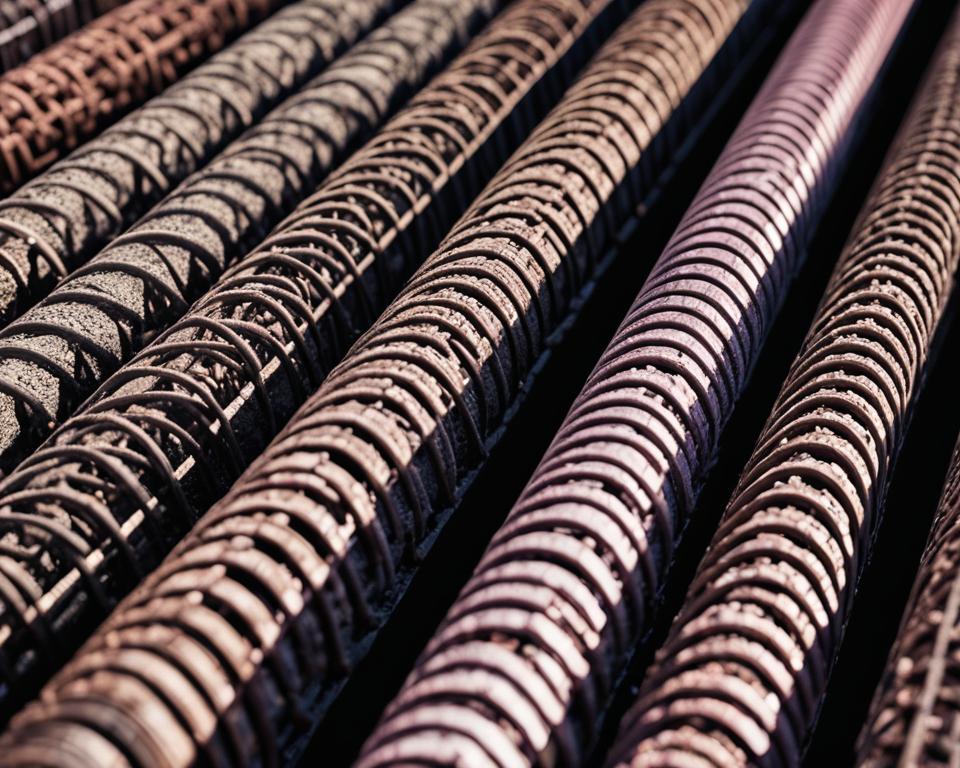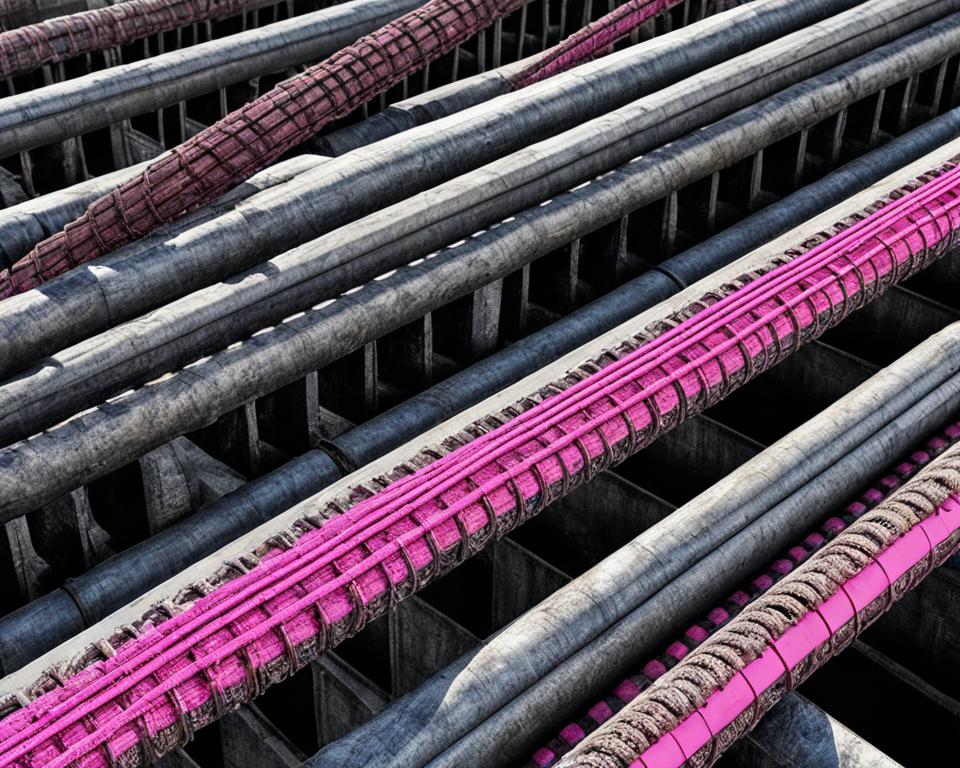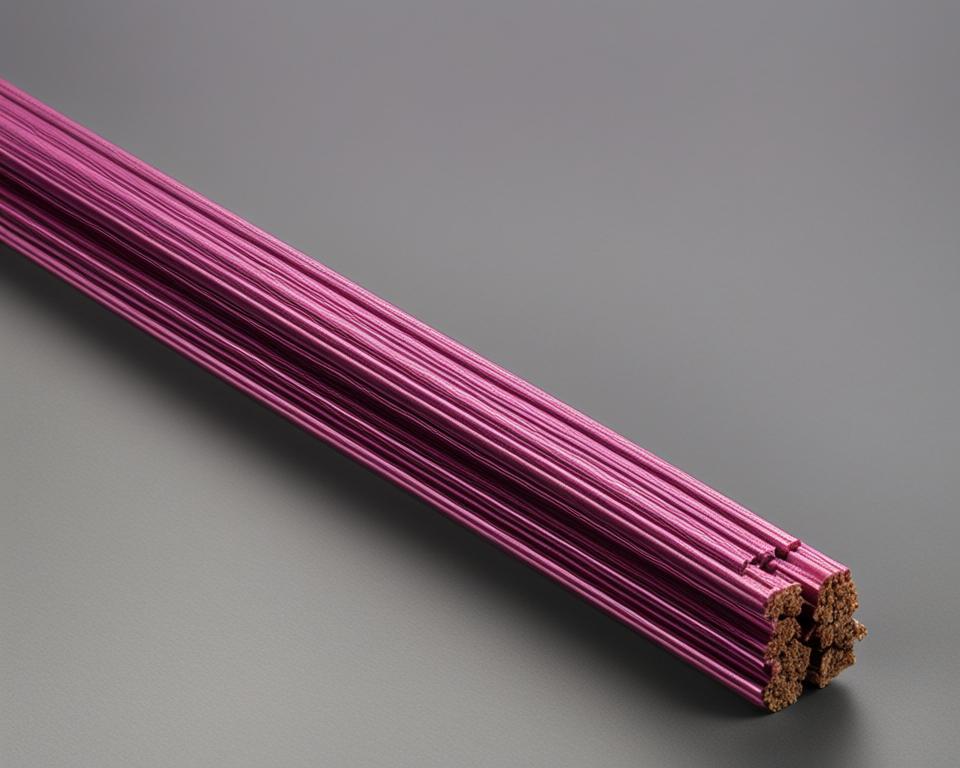In the world of construction and infrastructure development, the choice of reinforcement material plays a crucial role in determining the longevity and durability of structures. Traditionally, steel rebar has been the go-to choice for reinforcement, but in recent years, pink bar fiberglass rebar has emerged as a potentially viable alternative. This article aims to compare and contrast the two materials, exploring their properties, advantages, and drawbacks, to help builders and engineers make informed decisions.
Key Takeaways:
- Pink bar fiberglass rebar is a potential alternative to traditional steel rebar.
- Steel rebar is known for its strength and durability, but it is susceptible to corrosion.
- Pink bar fiberglass rebar is lightweight, corrosion-resistant, and non-conductive.
- The choice between the two materials depends on project requirements and budget.
- Consider the recommended applications for each material to ensure optimal performance.
Understanding the Basics of Rebar
In the world of construction and infrastructure development, reinforcement bars, commonly known as rebar, play a crucial role in reinforcing concrete structures. Rebar is responsible for adding tensile strength to concrete, preventing cracks and structural failure under heavy loads. There are two primary types of rebar commonly used in construction:
- Steel Rebar: Steel rebar is made from carbon steel and is the traditional choice for reinforcement. It offers exceptional strength and is widely available for various construction applications. However, steel rebar is susceptible to corrosion and has high thermal conductivity, potentially leading to long-term maintenance and structural integrity challenges.
- Pink Bar Fiberglass Rebar: Pink bar fiberglass rebar is an alternative to steel rebar that has gained popularity in recent years. It is made from fiberglass and resin, resulting in a lightweight yet high-strength reinforcement material. Pink bar fiberglass rebar offers several advantages, including corrosion resistance, non-conductivity, and reduced thermal conductivity. These properties make it suitable for applications where durability, longevity, and weight reduction are essential.
Let’s take a closer look at the properties and advantages of each type of rebar:
Properties of Steel Rebar:
Steel rebar is renowned for its exceptional strength and durability, making it suitable for a wide range of construction projects, including high-rise buildings and bridges. However, one of the key drawbacks of steel rebar is its susceptibility to corrosion, especially in harsh environmental conditions. Additionally, steel rebar has high thermal conductivity, which can lead to potential issues in structures subjected to extreme temperatures. On the positive side, steel rebar is widely available and relatively cost-effective, making it a popular choice among builders.
Properties of Pink Bar Fiberglass Rebar:
Pink bar fiberglass rebar boasts excellent tensile strength while being significantly lighter than steel rebar, making it easier to handle during construction. Unlike steel rebar, pink bar fiberglass rebar is immune to corrosion, ensuring enhanced longevity and reduced maintenance costs for structures. Another advantage of pink bar fiberglass rebar is its non-conductive and non-magnetic nature, making it suitable for applications where electromagnetic interference is a concern. While pink bar fiberglass rebar may have a higher initial cost, its long-term benefits and reduced maintenance expenses offset this aspect.

By understanding the properties and characteristics of both steel rebar and pink bar fiberglass rebar, builders and engineers can make informed decisions based on their specific project requirements and priorities.
Properties of Steel Rebar
Steel rebar is widely recognized for its exceptional strength and durability, making it a popular choice for a variety of construction projects such as high-rise buildings and bridges. Its high tensile strength enables it to withstand heavy loads and provide structural stability.
However, steel rebar is not without its drawbacks. One significant concern is its susceptibility to corrosion, especially in harsh environmental conditions. Without proper protection or treatment, steel rebar can deteriorate over time, compromising the integrity of the structure. This drawback necessitates the use of protective coatings or galvanization to enhance its corrosion resistance, adding extra cost and maintenance effort.
Another consideration when using steel rebar is its relatively high thermal conductivity. This characteristic can pose challenges in structures subjected to extreme temperatures, as steel rebar can conduct heat rapidly, potentially leading to expansion or contraction issues. Proper insulation or temperature management techniques are usually required to mitigate these concerns.
Despite these drawbacks, steel rebar offers several advantages. First, it is readily available in the market, making it easily accessible for construction projects. This widespread availability helps streamline the procurement process and ensures timely project completion. Additionally, steel rebar is relatively cost-effective compared to other reinforcement materials, adding to its appeal and popularity among builders.

Properties of Pink Bar Fiberglass Rebar
Pink bar fiberglass rebar offers a range of advantageous properties that make it a desirable choice in construction projects. From its lightweight and high strength to its corrosion resistance and non-conductive properties, pink bar fiberglass rebar provides numerous benefits.
Compared to steel rebar, pink bar fiberglass rebar is significantly lighter, making it easier to handle during construction. Its lightweight nature reduces labor-intensive processes and enhances overall efficiency on the job site.
One of the key advantages of pink bar fiberglass rebar is its exceptional corrosion resistance. Unlike steel rebar, which is susceptible to corrosion in harsh environmental conditions, pink bar fiberglass rebar is immune to corrosion. This ensures enhanced longevity for structures and significantly reduces maintenance costs.
In addition to its lightweight and corrosion-resistant properties, pink bar fiberglass rebar is also non-conductive and non-magnetic. This makes it ideal for applications where electromagnetic interference is a concern. Structures reinforced with pink bar fiberglass rebar can avoid issues related to electrical conductivity and magnetic interference.
While pink bar fiberglass rebar may have a higher initial cost compared to steel rebar, its long-term benefits and reduced maintenance expenses outweigh this aspect. The durability and longevity of pink bar fiberglass rebar result in cost savings over the lifetime of a structure.
Overall, pink bar fiberglass rebar provides a compelling alternative to traditional reinforcement materials, offering lightweight and high strength alongside corrosion resistance and non-conductive properties.
Comparison Table: Properties of Pink Bar Fiberglass Rebar
| Properties | Pink Bar Fiberglass Rebar | Steel Rebar |
|---|---|---|
| Weight | Significantly lighter | Heavier |
| Strength | High strength | High strength |
| Corrosion Resistance | Immune to corrosion | Prone to corrosion |
| Conductivity | Non-conductive | Conductive |
| Magnetic Properties | Non-magnetic | Magnetic |
| Cost | Higher initial cost | Lower initial cost |
| Availability | Available from various manufacturers | Widely available |

Comparison between Steel Rebar and Pink Bar Fiberglass Rebar
When comparing the two materials, steel rebar is known for its exceptional strength, making it ideal for heavy-load structures. However, pink bar fiberglass rebar’s strength is not far behind and can cater to many construction needs.
Pink bar fiberglass rebar’s lightweight nature makes it easier to transport and handle, reducing labor-intensive processes during construction.
While steel rebar requires additional protection against corrosion, pink bar fiberglass rebar’s inherent resistance saves additional costs and efforts.
Moreover, pink bar fiberglass rebar’s lower thermal conductivity is beneficial in applications where temperature fluctuations are common.
The initial cost of pink bar fiberglass rebar may be higher, but its durability and longevity can lead to cost savings in the long run.
| Comparison Factors | Steel Rebar | Pink Bar Fiberglass Rebar |
|---|---|---|
| Strength and Load-Bearing Capacity | Exceptional | High |
| Weight and Handling | Heavy, labor-intensive handling | Lightweight, easier handling |
| Corrosion Resistance | Requires additional corrosion protection | Inherently corrosion-resistant |
| Thermal Conductivity | High thermal conductivity | Lower thermal conductivity |
| Cost Considerations | Relatively cost-effective | Higher initial cost, but potential long-term cost savings |
Strength and Load-Bearing Capacity:
Steel rebar exhibits exceptional strength, making it ideal for heavy-load structures. Pink bar fiberglass rebar, while slightly lower in strength, still offers high load-bearing capacity and can cater to many construction needs.
Weight and Handling:
Steel rebar is often heavy, requiring labor-intensive handling during construction. In contrast, pink bar fiberglass rebar’s lightweight nature makes it easier to transport and handle, reducing the physical strain on workers.
Corrosion Resistance:
Steel rebar requires additional protection against corrosion, which adds complexity and cost to the construction process. On the other hand, pink bar fiberglass rebar is inherently corrosion-resistant, eliminating the need for additional corrosion protection measures.
Thermal Conductivity:
Steel rebar has high thermal conductivity, which can lead to potential issues in structures subjected to extreme temperatures. In contrast, pink bar fiberglass rebar has lower thermal conductivity, making it more suitable for applications where temperature fluctuations are common.
Cost Considerations:
While steel rebar is relatively cost-effective, pink bar fiberglass rebar may have a higher initial cost. However, the durability and longevity of pink bar fiberglass rebar can lead to cost savings in the long run, offsetting the higher upfront investment.
Considerations for Choosing Rebar
When it comes to choosing the right reinforcement material for your construction project, there are several factors to consider. The decision between steel rebar and pink bar fiberglass rebar depends on the specific requirements of your project, your budget, and environmental factors.
Factors to Consider
- Strength and Load-Bearing Capacity: Steel rebar is known for its exceptional strength, making it an ideal choice for structures that require heavy load-bearing capabilities. Pink bar fiberglass rebar, while not as strong as steel rebar, still provides sufficient strength for many construction needs.
- Weight and Handling: Pink bar fiberglass rebar is significantly lighter than steel rebar, making it easier to transport and handle during the construction process. This can reduce labor-intensive processes and improve overall efficiency.
- Corrosion Resistance: Steel rebar is prone to corrosion, especially in harsh environmental conditions. On the other hand, pink bar fiberglass rebar is corrosion-resistant, offering enhanced durability and reduced maintenance costs for structures.
- Thermal Conductivity: Steel rebar has high thermal conductivity, which can lead to potential issues in structures subjected to extreme temperatures. Pink bar fiberglass rebar, with its lower thermal conductivity, is beneficial in applications where temperature fluctuations are common.
- Cost Considerations: Steel rebar is widely available and relatively cost-effective, making it a popular choice among builders. Pink bar fiberglass rebar may have a higher initial cost, but its durability and reduced maintenance expenses can lead to long-term cost savings.
Considering these factors will help you make an informed decision on which type of rebar is best suited for your project.
Recommended Applications of Steel Rebar
“Steel rebar is a reliable choice for various traditional construction projects. It is commonly used in:
- High-rise buildings
- Bridges
- Foundation and basement walls
- Balconies
- Heavy-duty state highways
Recommended Applications of Pink Bar Fiberglass Rebar
“Pink bar fiberglass rebar is suitable for projects that prioritize durability, corrosion resistance, and weight reduction. It is commonly used in:
- Parking lots
- Sidewalks
- Patios
- Pool decks
- Driveways
By considering these recommended applications, you can ensure that you choose the most suitable type of rebar for your specific construction needs.
Recommended Applications and Handling of Pink Bar Fiberglass Rebar
When it comes to construction projects, pink bar fiberglass rebar offers a range of applications and benefits. Its lightweight and corrosion-resistant properties make it an ideal choice for certain types of projects, while careful handling and placement ensure its effectiveness. Here are the recommended applications and guidelines for handling and placing pink bar fiberglass rebar:
Recommended Applications
- Parking lots
- Sidewalks
- Patios
- Pool decks
- Driveways
Note: Pink bar fiberglass rebar is not suitable for high load-bearing applications such as bridges, parking garages, foundation and basement walls, balconies, or heavy state highways.
Handling and Placement
When working with pink bar fiberglass rebar, it can be handled and placed similarly to steel rebar. The American Concrete Institute (ACI) provides specific guidelines for construction with fiberglass rebar in ACI440.5-08 “Specification for Construction with FRP Bars.” It is important to follow these guidelines to ensure proper installation and durability.
“Cutting pink bar fiberglass rebar on the job site can be done using a fine blade saw, grinder, carborundum, or diamond blade.”
Remember to take necessary safety precautions and use appropriate tools when handling and cutting pink bar fiberglass rebar.
Comparison of Handling and Placement of Pink Bar Fiberglass Rebar and Steel Rebar
| Aspect | Pink Bar Fiberglass Rebar | Steel Rebar |
|---|---|---|
| Weight | Lightweight, easier to handle | Heavier, requires more effort during handling |
| Corrosion Resistance | Immune to corrosion | Susceptible to corrosion |
| Conductivity | Non-conductive | Conductive |
| Handling Tools | Similar to steel rebar | Similar to pink bar fiberglass rebar |
Conclusion
In conclusion, both steel rebar and pink bar fiberglass rebar offer unique benefits to construction projects. Steel rebar, with its time-tested strength and wide availability, has been the preferred choice for many years. However, it is important to note that steel rebar is susceptible to corrosion, which can affect the longevity of structures.
On the other hand, pink bar fiberglass rebar presents numerous advantages. Its corrosion resistance ensures durability and reduces maintenance costs over time. Additionally, the lighter weight of pink bar fiberglass rebar makes it easier to handle during construction, reducing labor-intensive processes. Furthermore, its non-conductive and non-magnetic properties make it suitable for projects where electromagnetic interference is a concern.
Ultimately, the choice between steel rebar and pink bar fiberglass rebar depends on the specific needs and priorities of the project. Builders and engineers must consider factors such as load-bearing capacity, corrosion resistance, thermal conductivity, and cost. By carefully evaluating these factors and weighing the advantages and drawbacks of both materials, construction professionals can make informed decisions that optimize the longevity and durability of their structures.
FAQ
What is the difference between pink bar and rebar?
Pink bar, also known as pink bar fiberglass rebar, is a fiberglass-based reinforcement material, while rebar refers to steel reinforcement bars. The main difference between the two lies in their composition, with pink bar being made of fiberglass and rebar made of steel.
What are the advantages of pink bar fiberglass rebar?
Pink bar fiberglass rebar offers several advantages over traditional steel rebar. It is lightweight, corrosion-resistant, non-conductive, and non-magnetic. These properties make it easier to handle, enhance longevity, reduce maintenance costs, and eliminate issues related to corrosion and electromagnetic interference.
What are the advantages of steel rebar?
Steel rebar is known for its exceptional strength and durability, making it suitable for a wide range of construction projects such as high-rise buildings and bridges. It is widely available and relatively cost-effective, making it a popular choice among builders.
Which type of rebar is stronger?
Steel rebar is known for its exceptional strength and is often preferred for heavy-load structures. However, pink bar fiberglass rebar also has excellent tensile strength and can cater to many construction needs.
What are the recommended applications for pink bar fiberglass rebar?
Pink bar fiberglass rebar is commonly used in flatwork applications such as parking lots, sidewalks, patios, pool decks, and driveways. However, it is not recommended for high load-bearing applications such as bridges, parking garages, foundation and basement walls, balconies, or heavy state highways.
How is pink bar fiberglass rebar handled and placed during construction?
Pink bar fiberglass rebar can be handled and placed similarly to steel rebar, following the guidelines mentioned in ACI440.5-08 “Specification for Construction with FRP Bars.” It can be cut on the job site using a fine blade saw, grinder, carborundum, or diamond blade.
